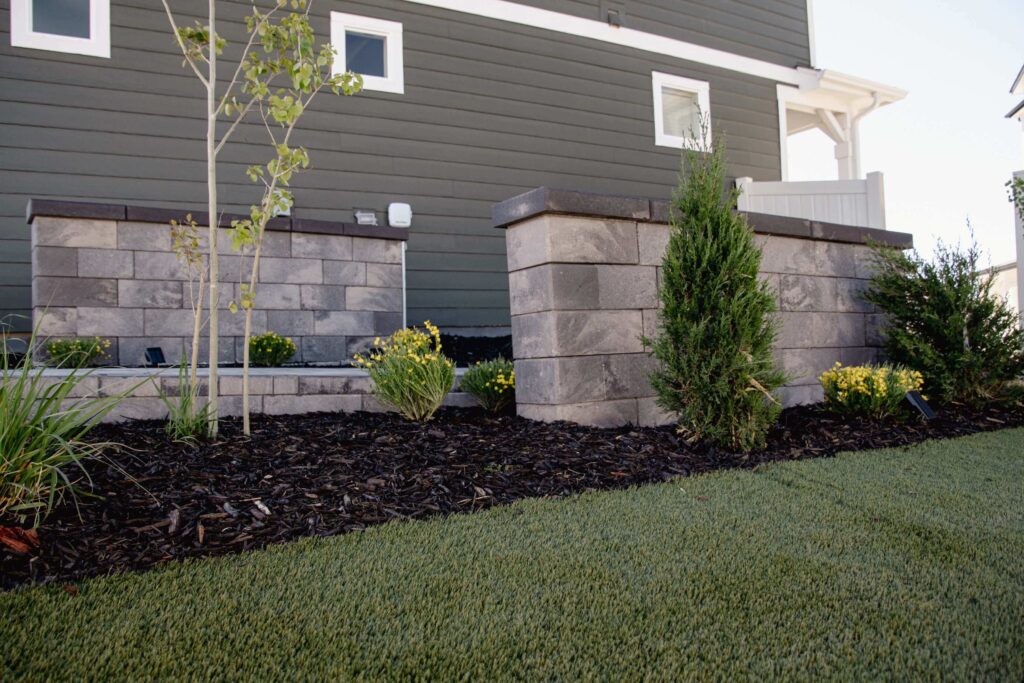When it comes to enhancing your outdoor space, understanding the difference between landscaping and hardscaping is crucial. These two concepts may sound similar, and while they work hand-in-hand to create a balanced, beautiful yard, they each serve distinct functions in the design and structure of your outdoor environment.
Whether you’re dreaming of a backyard oasis with a stone patio and lush greenery or planning a low-maintenance front yard makeover, this guide will walk you through the essential differences—and help you decide what your Colorado home truly needs.
What is Landscaping?
Landscaping refers to the living, organic elements of your yard. Think of it as everything that grows, blooms, or breathes life into your outdoor space. It includes:
- Artificial Grass, shrubs, flowers, and trees
- Garden beds and turf installation
- Irrigation systems for plant care
- Soil grading and fertilization
- Seasonal maintenance and cleanup
Landscaping is about aesthetics, sustainability, and seasonal upkeep. It plays a key role in the overall curb appeal of your property and can increase the value of your home when done right. A well-maintained landscape not only adds beauty but also supports your local ecosystem by attracting pollinators and managing water runoff.
What is Hardscaping?
Hardscaping, on the other hand, includes all the non-living, structural components of your outdoor space. This involves permanent or semi-permanent installations such as:
- Patios, walkways, and driveways
- Retaining walls and stone steps
- Fire pits, outdoor kitchens, and seating areas
- Water features like fountains and ponds
- Pergolas, fences, and decks
Hardscaping creates the framework and functionality of your yard. It’s especially useful in Colorado’s varied terrain, offering erosion control and structural support while also making the space usable year-round. Materials commonly used include natural stone, concrete, pavers, wood, and metal.
Key Differences Between Landscaping and Hardscaping
The difference between landscaping and hardscaping lies not only in materials but in purpose, maintenance, and design considerations. Here’s a breakdown:
| Aspect | Landscaping | Hardscaping |
|---|---|---|
| Components | Plants, grass, flowers, soil | Stone, concrete, wood, metal |
| Function | Aesthetic, environmental, seasonal | Structural, functional, long-lasting |
| Maintenance | Regular (watering, pruning, fertilizing) | Occasional (cleaning, sealing) |
| Cost | Typically lower upfront, ongoing upkeep | Higher upfront, lower maintenance |
| Lifespan | Seasonal/biological lifecycle | Durable, permanent |
Understanding these differences helps homeowners make informed decisions when planning an outdoor renovation or new installation.
How Landscaping and Hardscaping Work Together
Rather than thinking of hardscaping and landscaping as separate, it’s more accurate to view them as two halves of a whole. A successful outdoor design relies on the balance between natural and built environments.
For example:
- A flagstone patio (hardscape) becomes more inviting when surrounded by blooming flower beds (landscape).
- A retaining wall (hardscape) can double as raised garden beds.
- Pathways (hardscape) guide visitors through manicured lawns and shaded trees (landscape).
This synergy not only enhances beauty but also improves usability. Especially in Colorado, where elevation changes, drought, and heavy snowfall can pose challenges, combining the right elements ensures both durability and visual appeal.
Read also: Pavers vs Concrete Patio: What’s the difference and which is better?
Benefits of Hardscaping and Landscaping for Homeowners
1. Increased Property Value
Professionally designed outdoor spaces can raise your home’s value by up to 20%, according to national real estate studies.
2. Curb Appeal
First impressions matter. A thoughtfully landscaped and hardscaped yard speaks volumes about care, taste, and investment.
3. Low Maintenance Options
While landscaping requires more regular attention, many homeowners choose drought-tolerant plants, mulch beds, or xeriscaping to reduce upkeep. Similarly, hardscaping reduces the need for mowing or constant watering.
4. Year-Round Use
Fire pits, patios, and covered pergolas extend your outdoor living space across all four seasons—a big plus in areas like Colorado with varying weather.
5. Environmental Responsibility
Landscaping with native plants helps conserve water and support wildlife. Proper hardscape design can direct drainage and prevent erosion, contributing to a more sustainable property.
When to Focus on Landscaping vs. Hardscaping
Not every home improvement project requires both. Consider the following when prioritizing:
- New Builds or Major Renovations: Start with hardscaping to set the structure, then layer landscaping afterward.
- Budget Projects: Begin with landscaping for immediate impact, and add hardscaping features over time.
- Sloped or Erosion-Prone Yards: Retaining walls or terracing (hardscaping) may be essential before adding plants.
- Entertaining Goals: Outdoor kitchens, decks, and fire pits may take precedence for homeowners who love to host.
Final Thoughts: Choosing the Right Balance
Whether your vision includes winding garden paths or a cozy fire pit retreat, knowing the difference between landscaping and hardscaping will help you design an outdoor space that’s beautiful, functional, and built to last.
The best results come from a plan that integrates both elements in harmony—leveraging structure and nature to complement your home and lifestyle. Work with professionals who understand the local Colorado environment to choose materials and plants that thrive in your climate and terrain.
Ready to Transform Your Outdoor Space?
Whether you’re looking to upgrade your garden or install a brand-new patio, balancing landscaping and hardscaping is the key to a successful and long-lasting outdoor space.
ORO Landscape is your trusted expert for outdoor design and installation across Colorado. Contact us today to schedule a consultation and bring your vision to life.

